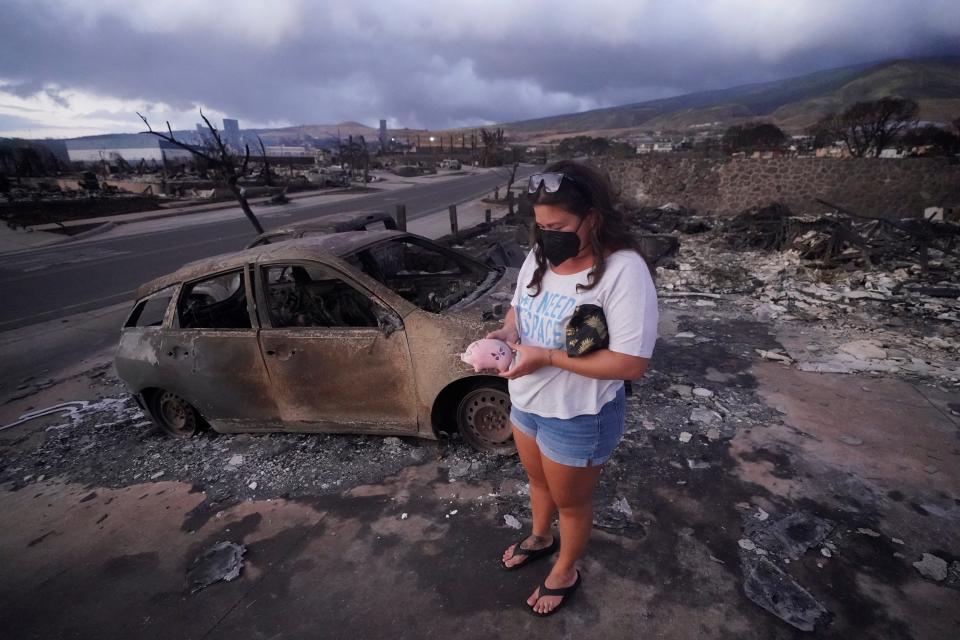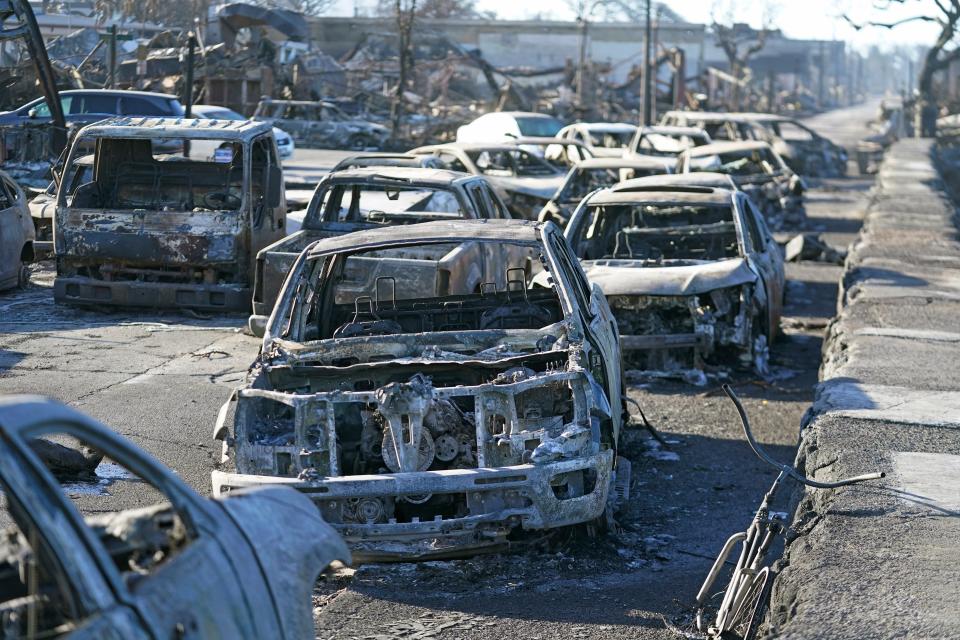What went wrong in Maui? As 'cataclysmic' fires grew, many heard no warnings
Hawaii State Sen. Angus McKelvey started hearing explosions in Lahaina as he was running errands. Hours later, he said he could see burning embers “raining down from the sky” and several homes on fire as he drove to his brother's house to check on the family pets. A nearby apartment building stood engulfed by large balls of fire, and by the time he returned home, flames were lighting up his condo.
As the destruction spread, McKelvey never heard emergency sirens or alarms. He didn't see police overseeing evacuations. Like other residents trying to flee the area, he said, he was uncertain about what to do next.
For the rest of the night Tuesday, McKelvey saw Lahaina, the historic tourist town he was born and raised in, erupt in flames "like a war zone."
McKelvey is part of a growing chorus of voices questioning what, if anything, went wrong in Maui in fires that have claimed at least 93 lives, destroyed more than 2,200 structures and scorched more than 2,100 acres. Locals are questioning whether residents were given enough notice via sirens or other notifications as the wildfire swept through. There are also questions about whether the area had the resources to help people, including enough firefighters.
About 1,000 people were still missing, Maui County Police Chief John Pelletier said.
"There probably should have been a more aggressive activation at the onset, more preparation," McKelvey told USA TODAY. "We heard about the red flag warning as brush fires were definitely a concern initially, not this cataclysmic totality that overwhelmed the community."

Fire weather watch was issued two days before wildfires began
The warning signs came early, McKelvey said. On Aug. 6, the National Weather Service in Honolulu issued a "fire weather watch" for the state after fears about Hurricane Dora soaking the area subsided. "Strong and gusty winds, combined with low humidities ... may lead to critical fire conditions across leeward areas over the coming days," the watch said.
The next day, on Aug. 7, the weather service issued "a red flag warning" as dry areas, combined with "strong and gusty easterly winds" of 30 to 45 mph with gusts up to 65 mph, were expected. "Any fires that develop will likely spread rapidly," officials warned.
And that's exactly what happened early Aug. 8 as catastrophic wildfires swept through Maui's west side fueled by intense winds with gusts as high as 80 mph from Hurricane Dora to the south.

Did warning sirens sound before the fires?
It's still unclear what steps local officials took to warn residents.
"I think this was an impossible situation," Maui Mayor Richard Bissen said on NBC's "Today" show on Friday. "I can’t comment on whether or not the sirens sounded, but I know the fires came up so quickly and they spread so fast. There were some initially, when there was a smaller fire. Homes were evacuated."
Hawaii Emergency Management records showed no indication warning sirens were triggered before the fires erupted, officials told The Associated Press on Thursday. Emergency Management Agency spokesperson Adam Weintraub said the department’s records don’t show Maui’s warning sirens were triggered Tuesday when the Lahaina fire began.
Instead, the county used emergency alerts sent to mobile phones, televisions and radio stations, Weintraub said. But power and cellular outages may have limited the alert's reach.
Maui’s ability to fight the fires may also have been hampered by a small staff, said Bobby Lee, president of the Hawaii Firefighters Association. A maximum of 65 firefighters are working at any given time in Maui County, and they are responsible for fighting fires on three islands: Maui, Molokai and Lanai, he said.
Those crews have more than a dozen fire engines and two ladder trucks, but the department does not have any off-road vehicles, he said. That means fire crews can’t attack brush fires thoroughly before they reach roads or populated areas.
Business owner J.D. Hessemer told CBS News he evacuated before the fires hit his neighborhood but never heard an emergency alert. "The winds were just getting out of control. Power lines were down everywhere and we had to reroute," Hessemer told "CBS Mornings" on Friday. "We just decided it was not safe to stay around for the day."
People running out of food, fuel
Elizabeth Pickett, co-executive director of the nonprofit Hawaii Wildfire Management Organization, told the Honolulu Civil Beat the fire was foreseeable.
"We keep hearing from certain elected officials and other people being quoted in the media, 'We had no idea, this is unprecedented,'" Pickett said Thursday. "But actually, those of us in the wildfire community, meaning our fire agencies, our forestry natural resource management community, we have long been working to increase our risk reduction efforts."
McKelvey said more people should have been told to leave their homes.
"I think there would’ve been a stronger urge to evacuate with some better planning," McKelvey said. "It's hard."
He said there is "an urgent and desperate need" for power lines to be restored. If not, he hopes federal officials will consider bringing in mobile vans or trailers that offer wireless coverage to ravaged areas as shortages of food, water and fuel grow.
"There are so many questions that need to be answered," McKelvey said. "But right now, there are a lot of people worried to death about their family members and friends who are missing and don't know if they are alive or dead."
Wildfires can be difficult to predict, disaster expert says
Despite the weather service's official warnings, Karl Kim, executive director for the National Disaster Preparedness Training Center at the University of Hawaii, said Thursday that even he was surprised by the level of devastation and deaths from the fast-spreading wildfires.
"Even the best of us can be second-guessed by a red flag warning, not considering how that it might affect us directly," Kim said.
Hawaii has among the largest integrated outdoor all-hazard public safety warning systems in the United States. Despite nearly 400 sirens islandwide to alert residents of natural disasters such as hurricanes, tsunamis, flooding, volcano eruptions and earthquakes, wildfires can be difficult hazards to track, Kim said. He said he doesn't know whether any of those sirens were triggered by the fires.
"Out of all of the threats, wildfires are the most difficult to predict, unlike hurricanes and volcanos, because we have much better detection alerts and warning systems in place" for those, Kim said. "A wildfire can be triggered in many different ways, by strong winds, lightning, people disposing of cigarette butts, and other human causes."
He said the tragedy shows the need to understand the science of wildfires, as well as use technology such as costly mobile sensors that detect gas, smoke and flames, particularly in remote wildfire-prone areas. Questions are being raised on where to place them and how to connect them to the internet or satellite communication systems.
A sensor unit that could be attached to a tree could cost about $250, Kim said. That cost, however, does not include any installation, connection service, maintenance and periodic testing.
Kim said the Maui wildfires involved a deadly combination of incredibly strong winds and "dry fuel," including brush, grass, trees and centuries-old wooden structures for houses, buildings and businesses.
"The wildfire took out main sources of communications as word didn't spread fast enough by phone and other means," Kim said. "And by the time you start smelling the smoke, unfortunately, it may be a little too late. This is a harsh wake-up call."
'Plenty of blame to go around'
Kim said that while there might have been warnings about possible fire dangers, many people tend to ignore them for various reasons, including longstanding tendencies that they "won't directly affect me."
Those beliefs are not uncommon, said Tricia Wachtendorf, a sociology professor and director of the Disaster Research Center at the University of Delaware. She said many residents might have been more focused on a hurricane hitting the island instead of the risk of fire danger.
"We don't associate these two types of natural hazards, in this case, a hurricane and a wildfire, as being related," Wachtendorf said.
There's a lot to learn going forward in terms of weather patterns, climate change and urbanization, Kim said. He called it "one of the most unprecedented disasters" in Hawaii's history.
"There's plenty of blame to go around, as it would be wrong to focus narrowly on the emergency response systems due to this incredible force of nature," Kim said. "This is a signal for us to do even more work on our preparedness and improving our technology and communications systems. And above, all understanding our own behavior patterns."
Contributing: The Associated Press
This article originally appeared on USA TODAY: As Hawaii wildfires burned, many didn't hear sirens. What went wrong?

